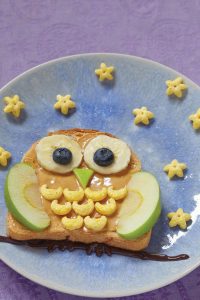School’s in! For some, that means ravenous and grumpy kids when the final bell rings. Molly Stryker, RD, LDN, the in-store nutritionist at Shop Rite of Timonium, is happy to help us navigate snacking options and find balanced ways to satisfy rumbling bellies without spoiling dinner.
 Fuel up early
Fuel up early
“Making sure your child has a well-balanced breakfast will jump start their metabolism and set them up for success the rest of the day,” Stryker says. “Try to include at least three food groups and pair complex carbohydrates (oatmeal, whole grain cereal or bread) with protein (Greek yogurt, eggs, nut butter) or healthy fats (avocados, nuts, seeds). Fiber, protein and fats affect the way we digest food resulting in a feeling of satiety for a longer amount of time.” A healthy breakfast can ward off hunger and help school performance.
Lunchtime choices figure in as well. “Pack your child’s lunch when you can,” Stryker advises. “Try to include a variety of fruit and vegetables, whole grains, lean protein and low-fat dairy.” Stryker also reminds us to keep kids hydrated. “Thirst can be easily mistaken for hunger. Send your child to school with their favorite water bottle and they may be more likely to drink throughout the day. Add some frozen berries or fun-shaped ice cubes to jazz it up.”
Watch portions
Even after breakfast and lunch, some kids go overboard with after-school snacking. “Snacks are just intended to hold you over until the next meal,” Stryker reminds us. “Your child does not need to feel full after a snack.”
It’s easy to confuse serving size (a standardized measure across brands) with portion. For example, the Nutrition Facts label on a box of crackers might say 15 crackers is a serving, but half of that could be a more appropriate portion for your child. Stryker says parents should consider a child’s age, size and activity level.
How do common snacks add up?
Kids often gravitate toward “treat” items as snacks. Here’s a glance at how some popular choices compare with healthier upgrades.
Cereals
Look for whole grains, lower sugar, higher fiber and cleaner ingredients.
• Kellogg’s Fruit Loops, 1 cup serving: 110 calories, 0.5 grams saturated fat, 150 milligrams sodium, 3 grams dietary fiber, 10 grams sugar; contains hydrogenated vegetable oil (trans fat), artificial colors, preservatives
• Kashi Heart to Heart Oat Cereal, ¾ cup serving: 120 calories, 0 grams saturated fat, 85 milligrams sodium, 4 grams dietary fiber, 5 grams sugar, 3 grams protein, whole grains
Popcorn
Air-popped is the gold standard, with fewer calories, no saturated fat, no sodium, no preservatives.
• Orville Redenbacher’s Movie Theatre Butter popcorn, 3 cup serving: 80 calories, 2.5 grams saturated fat, 170 milligrams sodium, 1.5 grams dietary fiber
• Whole popcorn kernels, air popped, 3 cup serving: 60 calories, 0 grams saturated fat, 0 grams sodium, 3 grams dietary fiber
Fruit vs. Fruit Snacks
Sorry, kids, but fruit snacks don’t count as fruit!
• Fruit Gushers, 1 pouch: 90 calories, 0.5 grams saturated fat, 12 grams sugar. Contains sugar, corn syrup, modified corn starch, fructose, maltodextrin, palm oil, glycerine, artificial colors and flavors
• Apple, 1 medium-sized, raw, with skin: 65 calories, 0 grams saturated fat, 0 milligrams sodium, 0 grams added sugars, 3 grams dietary fiber, 13 grams naturally occurring sugar, 10% of daily recommended intake of vitamin C
Yogurt
Greek yogurt may have more calories, but it has less sugar and fat, and boasts far more protein than kid-oriented varieties.
• Yoplait Trix Yogurt: 4-ounce cup, 100 calories, 0.5 grams saturated fat, 14 grams sugar, 3 grams protein
• Chobani plain, non-fat Greek yogurt: 5.3oz cup, 130 calories, 0 grams saturated fat, 6 grams sugar, 22 grams protein.
Applesauce
Unsweetened varieties have no added sugars, about half the sugar content per serving.
• Mott’s regular, 4-ounce cup: 90 calories, 0 grams saturated fat, 1 gram dietary fiber, 22 grams sugar
• Mott’s unsweetened, 4-ounce cup: 50 calories, 0 grams saturated fat, 1 gram dietary fiber, 11 grams sugar
“If your snack comes in a package, that’s a good sign that it is processed,” Stryker advises. Choose whole or minimally processed foods when possible and compare the nutritional content of packaged goods when stocking your pantry.
They’ll eat what you have
Easy gets eaten. “If you exclusively stock healthy foods, your child will eat them,” says Stryker. Check out our list of snack ideas. Prepare ahead of time. Kids can help you prep snacks on the weekends, making no-bake energy bites (peanut butter, oats, dates, honey, cinnamon) or cutting up fruit to freeze in individual bags to whip up a quick smoothie after school.
For kids who get home from school only to dash out to practice or a game or who will be tackling homework for hours, Stryker recognizes that they may need an extra boost. “Like any snack, think of it as a mini-meal and make it nutritious. Pair a complex carbohydrate (think whole grains, starchy vegetables or legumes) with a protein or healthy fat to give them the energy they need to sustain their activity.”
Convenience is tempting, but healthy alternatives aren’t as hard as you think. With a little advance planning and creativity, you can make smart after-school snacking the easy choice for your family.
Smart Snacking Ideas
• Air popped popcorn sprinkled with parmesan cheese
• Plain non-fat greek yogurt + fresh fruit or granola
• Whole wheat mini bagel + 1 tablespoon peanut butter
• 1 oz cheese stick + whole grain crackers
• Whole grain pita + hummus
• Whole grain tortilla chips + peach salsa
• Whole grain tortilla + peanut butter + berries (rolled and cut like sushi)
• Trail mix (nuts, seeds, dried fruit, dark chocolate, whole grain cereals)
• English muffin veggie pizzas
• Fruits or vegetables + Greek yogurt dip








